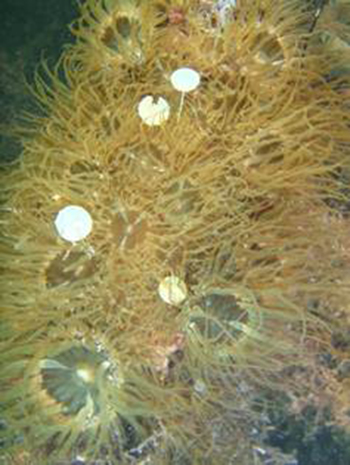Pale Anemone
Aiptasia allida

Taxonomy
Kingdom Animalia
Phylum Cnidaria
Class Anhozoa
Order Actiniaria
Family Aiptasiidae
Description
The Pale anemone, also known as the glass anemone, is usually dark brown to pale in color. It crows to be no more than 2 cm thick and 5 cm high. It has a thin column with many small or shot tentacles. The mouth is at the tip of its body. It has radial symmetry, and can have up to around 100 tentacles surrounding its mouth. This species is known as a pest in the marine environment (Berghia, 2011).
Ecology
Habitat
They usually stay in shallow waters, attaching themselves to rocks, or other hard substrate, such as red mangrove roots (Smithsonian, 2011). They also attach themselves onto coral, and end up either killing the coral, or making it move away because of its stinging. They are found in temperate, tropical, saltwater or marine environments such as the area between southeastern U.S. through the Caribbean. They usually grow in groups down to about 18 feet underwater, but can also be solitary.
Resources
The Pale anemone usually fees on zooplankton and receives energy from the zooxanthellae that have a symbiotic relationship with it. It also eats any organic matter which it catches with its tentacles. Feeding on the zooplankton can affect the amount of zooxanthellal photosynthetic oxygen production. It can cause a decrease in the number of zooxanthellae, which provide it with energy. Either the number of zooxanthellae is reduced, or the zooxanthellal process is changed for that individual anemone (Berghia, 2011).
Reproduction
Pale anemones reproduce asexually. They reproduce using a process called pedal laceration. In this process the adult anemone starts to grow smaller buds on its pedal which will eventually break off and grow to be genetically identical clones of the parent that it split from. Using this process, they can grow and spread fast once they find a suitable environment to grow in (Vaughn, 2011).
Behavior
The pale anemone, also known as the brown glass anemone, is very dangerous to corals. They have nematocys in their tentacles, which are poisons cells in their tentacles. These cells cause the coral which they grow on to die, or move away, if they can because of the repeated stinging that they have to endure. They are very hard to get rid of; they reproduce quickly and end up killing of all the coral and invertebrates surrounding the coral. The anemone can move by rolling on its side at about 4 centimeters per hour, again, aiding the death of the coral that it lives on (Vaughn, 2011).
Recent research
A recent research was done on the poisons that the nematocys in their tentacles create. The death of the poisons is fairly fast, sensitive, and reproducible. 0.1 μg protein/ ml was approximately how much the venom concentration was. Different venom concentrations were mainly because of the release of some materials from lysing cells. Some cations, such as Na+ or K+, were also involved in the alteration of the venom (Scopus, 2011).
Economic and Ecological Service
People usually buy the pale anemone to keep in their aquariums. They soon find out that they are a hazard to their marine environment (Nilsen et al., 2011). The sea anemone grows and reproduces rapidly on the coral, causing it to die, because of its stings. If not taken proper care of in the beginning, they could cause all of the coral to die. They are also a hazard in the ocean to coral. Scientists are worried that they may cause too much damage if they grow.
Personal Interest
The sea anemone caught my interest. Also because of Nemo, I wanted to find out more about anemone that live on corals. I did not expect to find out that some anemone end up harming the coral and fish. The way they reproduce also fascinated me, by budding off, they could make genetically identical clones. It was fun finding out about the pale anemone and its ecology.
References
"Aiptasia Biology." Berghia Verrucicornis (Aeolidiella Stephanieae) Nudibranch Educational Reference. Web. 27 May 2011.< http://www.berghia.org/aiptasiaBiology.html>.
"New Page 1." Smithsonian Marine Station (SMS) at Fort Pierce. Web. 27 May 2011.< http://www.sms.si.edu/IRLFieldGuide/Aiptas_pallid.htm>.
Nilsen, Alf J., Svein Fossa, and Ronald Shimek. "Brown Glass Anemone, Pale Anemone, Sea Anemone Facts and Sea Anemone Pictures of the Aiptasia Pallida." Dr. Jungles Exotic Pets, Animals, Aquariums. Extensive Encyclopedia of Animal Information, including Pet Care and Animal Pictures. Web. 27 May 2011.< http://animal-world.com/encyclo/reef/anemones/BrownGlassAnemone.php>..
Scopus, In. "ScienceDirect - Archives of Biochemistry and Biophysics : Assay and Properties of the Hemolysis Activity of Pure Venom from the Nematocysts of the Acontia of the Sea Anemone Aiptasia Pallida." ScienceDirect - Home. Web. 27 May 2011.< http://www.sciencedirect.com/science/article/pii/0003986173905006>.
Vaughn, Caitlin. "ADW: Aiptasia Pallida: Information." Animal Diversity Web. 19 Mar. 2011. Web. 27 May 2011.< http://animaldiversity.ummz.umich.edu/site/accounts/information/Aiptasia_pallida.html>